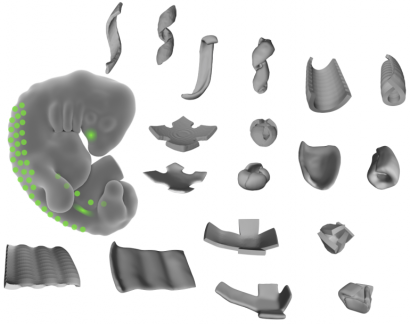- About
- Organization
- Organization Overview
- Dean’s Office
- Department of Bioengineering and Therapeutic Sciences
- Department of Clinical Pharmacy
- Department of Pharmaceutical Chemistry
- Quantitative Biosciences Institute
- Org Chart
- Research
- Education
- Patient Care
- People
- News
- Events
Cell-folding research opens door to building with biology
By Levi Gadye / Thu Jan 4, 2018

Scientists used contractile mesenchymal cells from mouse embryos to power self-folding living tissues.
As an animal develops from an embryo, vast platoons of cells grow, line up, and move around to form the complex shapes of a body—a heart, an ear, a thumb. Scientists have long sought to mimic this choreography to engineer better artificial limbs and organs.
Recent research in the UCSF School of Pharmacy, published December 28, 2017 in Developmental Cell8, has now revealed how sheets of cells are pulled and folded into shape during development, opening the door to better methods for building artificial tissues in the laboratory.
In the study, senior author Zev Gartner, PhD9, and colleagues, showed that particular arrangements of mesenchymal cells (a type of embryonic stem cell) could fold layers of cells into shapes that resemble bowls or ripples.
Gartner is a faculty member in the School’s Department of Pharmaceutical Chemistry10, and is a Chan Zuckerberg Biohub11 investigator and co-director of the UCSF Center for Cellular Construction12.
If cells are the building blocks of the body, then a dense network of microscopic fibers, known as the extracellular matrix (ECM), serves as the mortar and structural support for these blocks. Gartner’s research showed that during development, groups of mesenchymal cells function like a puppeteer controlling a marionette, using systems of “strings” to pull layers of cells, bound together by ECM, into the correct positions.
Remarkably, the researchers not only recreated this process in a petri dish, but were also able to coax layers of cells to form shapes not found in nature, such as cubes. The findings are the fruit of experimentation at the UCSF Center for Cellular Construction, which aims to “turn biology into an engineering discipline,” a goal that is rapidly being realized.
“We’re beginning to see that it’s possible to break down natural developmental processes into engineering principles that we can then repurpose to build and understand tissues,” said first author Alex Hughes, PhD, a postdoctoral scholar in the Gartner Lab14, in a UCSF news release15. “It’s a totally new angle in tissue engineering.”
Read more about this work
UCSF News: Engineers Hack Cell Biology to Create 3-D Shapes from Living Tissue15
Tech Crunch: It’s surprisingly easy to program living tissue to form new 3D shapes16
Tags
Keywords:
Category:
Research22
Sites:
School of Pharmacy, Department of Pharmaceutical Chemistry, PharmD Degree Program
About the School: The UCSF School of Pharmacy aims to solve the most pressing health care problems and strives to ensure that each patient receives the safest, most effective treatments. Our discoveries seed the development of novel therapies, and our researchers consistently lead the nation in NIH funding. The School’s doctor of pharmacy (PharmD) degree program, with its unique emphasis on scientific thinking, prepares students to be critical thinkers and leaders in their field.




